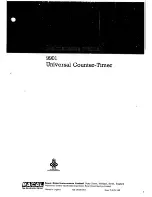
OSAKA- CI 49 Operating instructions. PAGE 3
4- OPERATING MODE
4.1 – FUNCTIONING OF THE COUNTING COMMANDS
To the first pulse received by the CNT input the counter goes in
counting mode that is signalled by the led SET/CNT.
Under this condition it is possible to visualize and to modify the
set, but it is not possible to program the parameters.
To enter in the parameters programming mode is needed to
reset the counter through the RESET input if par. “E”=1 or the
key F if par. "t" = 1.
The reset of the display and of the output happens
automatically when operation mode is "F1" = 1 (Restart) or "F1"
= 2 (Restart-lap) or can be manual through the RESET input if
par. “E”=1 or the key F if par. "t" = 1.
Through the parameter "E" it is possible to use the RESET
input to operate as command of reverse counting.
When you program the par. "E" = 2 to the activation of the input
the counting is reversed and therefore the acquired pulses are
subtracted if countig mode is UP ("C"=1) or added if countig
mode is DOWN ("C"=2).
In this operation mode it is necessary to pay attention at
counting speed because the Reset input have a delay of 15
msec. and therefore the inversion of the calculation is not
instant.
For this reason the use of the function recommends only when
the input frequency is low.
Using a contact that closes with advance in comparison to the
other to which is connected is possible to realize, for instance,
the following application of UP/DOWN counting.
With this UP/DOWN counting applications the counting cannot
assume negative values and therefore reached the value 0
(counting UP) or the set value (counting DOWN) others pulses
can’t be acquired.
In order of the model the counting signal can be from free
voltage contacts, from devices with transistor output NPN
(models with inputs C) or from voltage signals with the same
voltage of the instrument supply (models with inputs V).
The instruments with inputs type C have besides an output (12
VDC) to supply the counting device (proximity, photocell or
other) with transistor output NPN.
In order to the counting frequency is advisable to program the
filter software of the par. "H" that it allows to select the
maximum counting frequency and to avoid false counting (for
instance caused by the contacts rebounds).
Particularly for the instruments with inputs type V (voltage
signals) it recommends to program the parameter "H"< 3
because the instrument could count the pulses produced by the
main supply frequency.
4.2 – FUNCTIONING OF THE DISPLAY
The led SET/CNT is used to indicate the access into the
programming (flashing), the counting in action (on) or the
counting finished and the state of reset (off).
The counting in action is considered when the first pulse is
acquired after the reset.
After the reset, the display visualizes 0000 if the counting mode
is programmed as UP (par.
"C"
= 1) or it visualizes the
programmed set value if the counting mode is programmed as
DOWN (par.
"C"
= 2).
The par.
“d”
permits the user to divide the number of pulses
received by the input and to use the result as the counting
value of the counter (both for display and the outputs operating
mode).
4.3 - OUT1 OPERATING MODE
The instrument can be programmed by the parameter
"F1"
to
operate in any of the following 3 modes:
F1 = 1 - RESTART:
When reaching the programmed set or the 0000 value
(depending on whether the counting mode is UP or DOWN) the
ouput OUT1 is activated and it remains in this state for the
whole time programmed in the
"r"
parameter; the display
shows the value reached, and the counter does not count any
pulses received during this time.
When the "r" time has elapsed the output is deactivated and
the counter automatically resets counting, thus setting itself for
a new cycle: it then starts again to count the pulses received.
Therefore, reset of counting and output occurs when the "r"
time has elapsed.
F1 = 2 - RESTART-LAP:
This operating mode is similar to the previous one, the only
difference being that during the
"r"
time the counter - even
though it continues to display the value reached and maintains
the output activated - counts all the eventual pulses it receives.
When the "r" time has elapsed, output is deactivated and
counting continues starting from the value reached during the
"r" time.
Therefore, the counting reset occurs when the programmed set
has been reached, while the output OUT1 reset is carried out
when the "r" time has elapsed.
F1 = 3 - COUNT:
The output OUT1 is activated when the programmed set or the
0000 value have been reached (counting mode may be UP or
DOWN), and it remains activated until receiving the manual
reset control, which can be transmitted by the remote input
RES or the front key.























